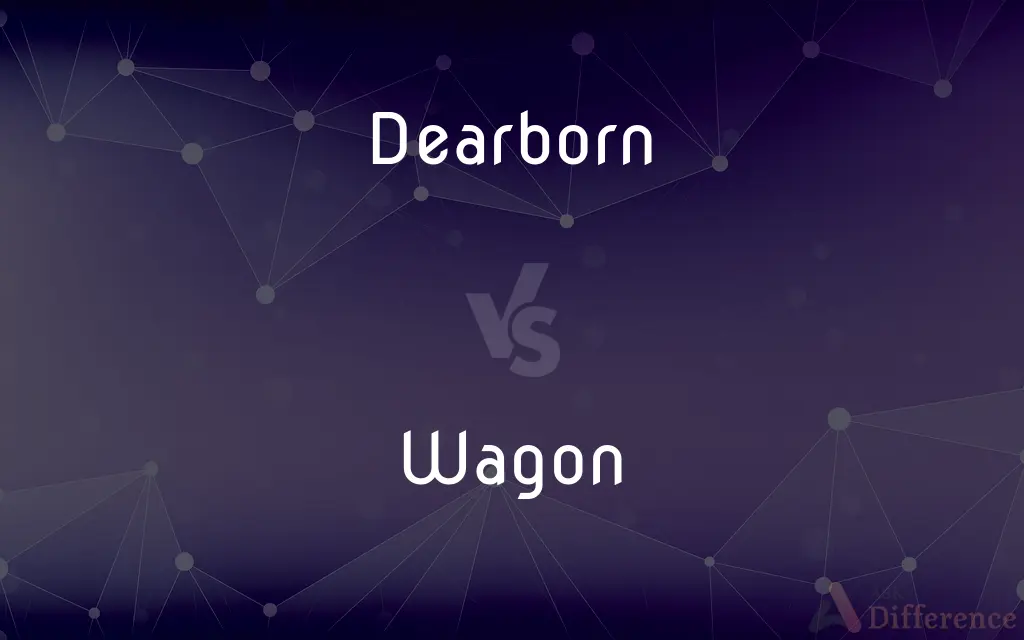Dearborn vs. Wagon — What's the Difference?
By Tayyaba Rehman & Fiza Rafique — Updated on April 3, 2024
Dearborn is a type of lightweight carriage, while a wagon is a four-wheeled, usually heavy vehicle for transporting goods or passengers.

Difference Between Dearborn and Wagon
Table of Contents
ADVERTISEMENT
Key Differences
Dearborns were specifically designed for personal transport, offering a lighter, more refined option for individuals and families in the 18th and 19th centuries. These carriages were often characterized by their sleek design and were typically pulled by one or two horses, making them suitable for shorter, smoother journeys. On the other hand, wagons are utilitarian vehicles designed to transport goods or people. They are built to be sturdy and can handle rougher terrain, being pulled by multiple horses or other animals. Wagons have been used for various purposes, from agricultural tasks to transporting goods over long distances.
The construction of a Dearborn focuses on comfort and ease of movement, featuring a suspension system that could absorb shocks from the road. This made Dearborns popular for day-to-day travel within towns or between nearby locations. Wagons, however, prioritize durability and capacity, often lacking the sophisticated suspension systems found in Dearborns. This makes wagon rides less comfortable, especially over uneven surfaces, but allows them to carry heavier loads and withstand more rigorous use.
In terms of design, Dearborns were often more aesthetically pleasing, with attention to details such as paint, trim, and upholstery. These features reflected the social status and personal tastes of their owners. Wagons are more functional in their design, with less emphasis on appearance and more on practicality. They are built to maximize space for cargo or passengers, with little to no decoration.
Dearborns and wagons differ in their historical contexts and uses. Dearborns were popular among the middle and upper classes in urban and suburban areas for personal transportation. They symbolize a bygone era of personal carriage travel. Wagons have a broader historical significance, being pivotal in the expansion of frontiers, particularly in the American West. They were essential for settlers transporting goods and families across long distances.
The terminology and usage of Dearborns and wagons highlight their different roles in transportation history. The term "Dearborn" is specific and less commonly used today, often associated with historical or collector circles. In contrast, "wagon" is a more general term, still in use, referring to various types of four-wheeled vehicles, including those in modern times designed for specific purposes like farm wagons or even children's toy wagons.
ADVERTISEMENT
Comparison Chart
Design Purpose
Personal transport, light and sleek
Transporting goods or people, sturdy
Typical Use
Shorter, smoother journeys
Long distances, rough terrain
Construction
Lightweight, with suspension system
Heavy, durable, often without sophisticated suspension
Design Aesthetics
Aesthetically pleasing, decorative
Functional, minimal decoration
Historical Context
Popular in 18th and 19th centuries for personal use
Essential for agricultural use and frontier expansion
Compare with Definitions
Dearborn
Features a suspension for smooth rides.
The ride was comfortable thanks to the Dearborn's suspension.
Wagon
Lacks sophisticated suspension, focusing on load capacity.
The wagon ride was bumpy over the uneven field.
Dearborn
Used mainly for day-to-day travel in earlier centuries.
They took the Dearborn for a quick visit to the neighboring village.
Wagon
A four-wheeled vehicle for goods or passengers.
The farmer loaded hay onto the wagon.
Dearborn
A lightweight carriage for personal use.
The family traveled to town in their Dearborn.
Wagon
Crucial for agricultural tasks and settling new lands.
Settlers packed their belongings into the wagon for the westward journey.
Dearborn
Characterized by its sleek design for comfort.
The Dearborn's elegant trim caught everyone's eye.
Wagon
More utilitarian, less about status.
The work wagon was an essential tool on the farm.
Dearborn
Reflects the owner's status and taste.
Owning a Dearborn was a sign of prosperity.
Wagon
Built to be sturdy and handle rough terrain.
The wagon was durable enough to traverse the rocky path.
Dearborn
A light carriage with four wheels, popular in the United States in the 1800s.
Wagon
A wagon or waggon is a heavy four-wheeled vehicle pulled by draught animals or on occasion by humans, used for transporting goods, commodities, agricultural materials, supplies and sometimes people. Wagons are immediately distinguished from carts (which have two wheels) and from lighter four-wheeled vehicles primarily for carrying people, such as carriages.
Dearborn
A light four-wheeled wagon.
Wagon
A vehicle used for transporting goods or another specified purpose
A breakdown wagon
A timber wagon
Dearborn
A four-wheeled carriage, with curtained sides.
Wagon
An unpleasant or disliked woman.
Wagon
A four-wheeled, usually horse-drawn vehicle with a large rectangular body, used for transporting loads.
Wagon
A light automotive transport or delivery vehicle.
Wagon
A station wagon.
Wagon
A police patrol wagon.
Wagon
A child's low, four-wheeled cart hauled by a long handle that governs the direction of the front wheels.
Wagon
A small table or tray on wheels used for serving drinks or food
A dessert wagon.
Wagon
Wagon The Big Dipper
Wagon
Chiefly British An open railway freight car.
Wagon
To transport or undergo transportation by wagon.
Wagon
A heavier four-wheeled (normally horse-drawn) vehicle designed to carry goods (or sometimes people).
Wagon
Abbreviation of toy wagon; A child's riding toy, with the same structure as a wagon (sense 1), pulled or steered by a long handle attached to the front.
Wagon
(rail) A vehicle (wagon) designed to transport goods or people on railway.
Wagon
(slang) transporting]] prisoners
Wagon
; (by extension) a sport utility vehicle (SUV); any car.
Wagon
A woman of loose morals, a promiscuous woman, a slapper; (by extension) a woman regarded as obnoxious; a bitch, a cow.
Thesaurus:promiscuous woman
Wagon
(math) A kind of prefix used in de Bruijn notation.
Wagon
(slang) Buttocks.
Wagon
To load into a wagon in preparation for transportation; to transport by means of a wagon.
Wagon
To travel in a wagon.
Wagon
A wheeled carriage; a vehicle on four wheels, and usually drawn by horses; especially, one used for carrying freight or merchandise.
Wagon
A freight car on a railway.
Wagon
A chariot
Wagon
The Dipper, or Charles's Wain.
Wagon
To transport in a wagon or wagons; as, goods are wagoned from city to city.
Wagon
To wagon goods as a business; as, the man wagons between Philadelphia and its suburbs.
Wagon
Any of various kinds of wheeled vehicles drawn by a horse or tractor
Wagon
Van used by police to transport prisoners
Wagon
A group of seven bright stars in the constellation Ursa Major
Wagon
A child's four-wheeled toy cart sometimes used for coasting
Wagon
A car that has a long body and rear door with space behind rear seat
Common Curiosities
Can wagons be used for personal transportation?
While wagons are more associated with cargo, they have historically been used for transporting families, especially by settlers.
Were Dearborns used for long journeys?
No, Dearborns were typically used for shorter, smoother journeys due to their design and comfort focus.
Do Dearborns have a unique design feature?
Yes, Dearborns often featured a suspension system for smoother rides and detailed aesthetics reflecting personal taste.
Is the term "Dearborn" still commonly used today?
The term "Dearborn" is more historical and specific, often associated with collector circles rather than common use.
What distinguishes a Dearborn from a wagon?
Dearborns are lightweight carriages for personal use, focusing on comfort, while wagons are sturdy, four-wheeled vehicles for transporting goods or people over various terrains.
What made wagons essential in American history?
Wagons were pivotal in the agricultural development and frontier expansion, helping transport goods and families across long distances.
How do Dearborns reflect social status?
The design and decorative aspects of Dearborns could indicate the owner's wealth and social standing.
Why are Dearborns considered elegant?
Their sleek design, attention to detail, and decorative elements made Dearborns symbolize elegance and refinement.
Why are wagons considered more utilitarian?
Wagons are designed to be durable and carry heavy loads, making them more functional and less focused on appearance.
How does the construction of Dearborns enhance comfort?
The lightweight design and suspension system in Dearborns are specifically intended to provide a smooth and comfortable ride.
Were Dearborns and wagons used at the same time period?
Yes, both were used in the 18th and 19th centuries, though for different purposes.
What are modern equivalents of wagons and Dearborns?
Modern equivalents include cars for Dearborns, focusing on personal transport and comfort, and trucks or utility vehicles for wagons, emphasizing cargo transport.
What role did wagons play in agriculture?
Wagons were essential in agriculture for transporting goods like crops and tools across farms.
Is the suspension system in Dearborns similar to modern vehicles?
While not as advanced, the suspension system in Dearborns was an early form of making rides smoother, akin to the goal of modern vehicle suspensions.
How did wagons contribute to the settlement of new lands?
Wagons were crucial for carrying supplies and belongings for settlers moving to new territories, enabling the expansion of frontiers.
Share Your Discovery

Previous Comparison
Pipa vs. Pita
Next Comparison
Explanatory vs. IlluminatoryAuthor Spotlight
Written by
Tayyaba RehmanTayyaba Rehman is a distinguished writer, currently serving as a primary contributor to askdifference.com. As a researcher in semantics and etymology, Tayyaba's passion for the complexity of languages and their distinctions has found a perfect home on the platform. Tayyaba delves into the intricacies of language, distinguishing between commonly confused words and phrases, thereby providing clarity for readers worldwide.
Co-written by
Fiza RafiqueFiza Rafique is a skilled content writer at AskDifference.com, where she meticulously refines and enhances written pieces. Drawing from her vast editorial expertise, Fiza ensures clarity, accuracy, and precision in every article. Passionate about language, she continually seeks to elevate the quality of content for readers worldwide.















































